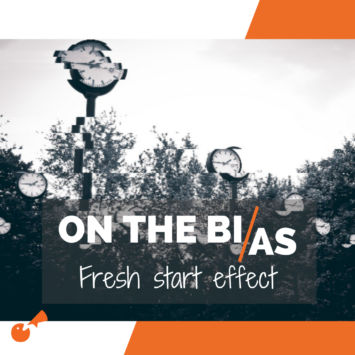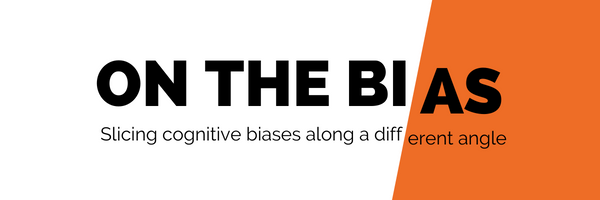
ON THE BIAS: Fresh Start Effect
Welcome back to the blog series, ON THE BIAS.
In this series, we look at the cognitive biases we have as humans and how they impact our behavior change efforts. Catch up with the previous posts here.

A story: A real pain in my side.
I started to notice a pain in my right side, around the lower rib cage, early last year. Figuring that I may have pulled something during my workouts, I pulled back on those exercises to let the self-diagnosed “injury” heal itself.
But the pain persisted and got worse at times, waking me in the middle of the night. After dealing with this constant pain for nearly a year, it was time for me to realize that it wasn’t going away on its own. I needed to get professional help.
Luckily, I had started following a physical therapist on Instagram who frequently shared exercises for reducing neck and back pain and was available for online sessions.
We held an initial consultation in early December, in which he was able to identify the root cause of my pain and recommend a mobility program to get me back on track.
I was delighted to hear that a solution to my pain may be within reach and expressed my enthusiasm to the physical therapist.
He asked, “When do you want to get started? This week?” as any good coach or trainer would.
And I responded with, “Um, how about the second week of January?” A full six weeks later!
What’s happening here?
Why on Earth would I endure another six weeks of pain if a solution was right in front of me?
It was not because I would be traveling during the December holidays. Nor was it a budget issue.
It was because of the fresh start effect.
In my mind, I needed to start this program at the beginning of the new year. Starting something new in December just didn’t sit right with me.
Is this rational? NO! But welcome to the world of cognitive biases.
ON THE BIAS: We often prefer to use the start of a new time period to set goals and attempt new behaviors.
“Fresh starts” can be the beginning of a new year, the start of a new week, the changing of seasons, or personal milestones like birthdays and anniversaries.
The days we choose may seem arbitrary on paper (is starting a new practice on a Monday really any different than starting it on a Friday – it’s just another day of the week?), but they represent significant milestones for us.
In their research paper on the fresh start effect, Dai et al. (2014) suggest that time markers help us divide the year into distinct periods in which we can create a pause to reflect upon the previous period, move on from things that didn’t go well, think about the big picture, and plan ahead.
Bringing the bias home: Think of an example when you have pushed the start of a new endeavor to a specific time marker like a new week or month, or a particular milestone date like an anniversary or seasonal solstice.
Consider why those moments felt like a “fresh start” to you. What factors made you feel more ready and capable to start or re-start something on that day? Do you think you could conjure those feelings on an alternate day if you had to?
Monday is always right around the corner if that helps with future fresh starts!
How this bias can help or hurt our behavior change programs
HOW IT HELPS
I think we all know this: motivating people to do something is hard. Heck, motivating ourselves to do something is hard!
The Fresh Start Effect helps our audiences pick an upcoming time marker to start a new practice. We can help audiences do this in the following ways.
Encouraging our audience to select a future time to get started provides several benefits beyond the fresh start effect: it prompts them to make a commitment to the new behavior, it helps them prepare for the next chapter, and it takes the immediate pressure off them (which could otherwise produce the reactance effect).
Alternatively, your outreach efforts could recommend a specific day or moment to start a new behavior. Meatless Mondays is a great example of this. The organization behind Meatless Mondays has an entire Monday Campaigns series utilizing the fresh start effect to address different health behaviors.
A few weeks ago, we explored the Sunk Cost Fallacy, which is the bias of pursuing a path we’ve invested time, effort, and money into even when a better alternative exists. One of the solutions for helping audiences let go of sunk costs is to align the new behavior with the fresh start effect.
Our designated “fresh start” moments permit us to turn over a new leaf without shame or guilt. Think of Marie Kondo: “This [insert project or habit] no longer sparks joy.”
HOW IT CAN HURT
My personal story exemplifies how this bias can work against us. Sometimes, audience members will delay the start of a new behavior too far into the future in search of a “perfect” start date.
A long waiting period creates a risk that their intentions will change during that time, or they’ll simply get distracted by daily life and forget to act.
If you sense this is happening, you can suggest a closer “fresh start” date while emphasizing the benefits the audience will gain by starting sooner rather than later.
2024 is coming up soon! You can build this strategy into your end-of-year and start-of-year outreach efforts to encourage more people to set goals and adopt new planet-friendly behaviors.
A NOTE OF CAUTION
At the start of January, your social media feeds will be inundated with articles claiming that New Year’s resolutions don’t work.
These are over-simplified, click-bait headlines, but there is a note of caution to consider with the Fresh Start Effect and New Year’s resolutions.
What motivates someone to start a new behavior will not be enough to keep them going. Additional motivators must be added to the mix to help the audience sustain what they’ve started. Tips on doing that are here.
Want to get fresh insights on the fresh start effect? Check out this published paper:
- Dai, H., Milkman, K. L., & Riis, J. (2014). The fresh start effect: Temporal landmarks motivate aspirational behavior. Management Science. Pp.1–20. https://doi.org/10.1287/mnsc.2014.1901. [PDF of the full paper].


